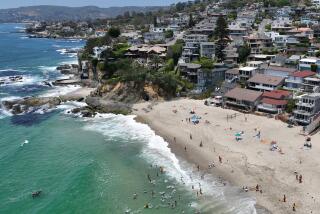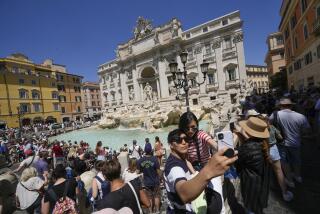World View : Tourist Boom: New Wealth and Woes : Countries need the hard currency that tourism provides, but do they need the ecological damage?
LONDON â There have been so many that their feet have actually worn down thousands-of-years-old pyramids in Mexico.
Their sheer physical weight has triggered cave-ins on the fells of Englandâs breath-taking Lake District.
Their millions of tons of human waste have choked the once-pristine beaches of Mexicoâs Acapulco Bay, Thailandâs Pattaya and Malaysiaâs Penang.
Their hotels have shot up so high and so fast that theyâve blotted out the very Spanish coastline they were meant to overlook, caused ancient thermal springs in Turkey to run dry and siphoned off the drinking water from drought-thirsty Indian villagers.
Their garbage has coated Mt. Everest. Their spilled American cola has eaten into the stone floor of Notre Dame Cathedral. Their sweat and breath have covered the 2,000-year-old cave paintings of Limoges with mold and white calcite.
And yet, they remain perhaps the most sought-after consumers in all the world.
They are the international tourists, the world travelers who help make the planet just a bit smaller and their lives just a bit fuller by spending their holidays beyond their own borders and shores.
Each year now, they are counted in the tens of millions. And taken together they are the clients of what has been dubbed the largest single industry on Earth--a $1-trillion economy built solely on the pursuit of fun, fantasy and foreign adventure.
During the last two decades of well-documented explosion in the international tourism market, entire nations have planned their future economies around these international consumers. For many, it is already their single largest source of foreign exchange. And for most it has become an income so vital that their economies simply can no longer survive without it.
Tourism is so important it is often overseen by Cabinet-level ministers. Governments spend hundreds of millions of dollars each year priming the tourism pump with subsidized hotels, tax incentives and public relations blitzes. Mexico, for example, is spending $10 million this year to hire a New York advertising agency and singer Linda Ronstadt to promote itself to American travelers.
Venezuela, seeking to cash in on the South American tourism vacuum left by the drug wars and insurgencies of nearby Colombia and Peru, has launched an ambitious plan to sell off more than a dozen state-owned hotels and use the expected $1 billion in earnings to help finance construction of dozens more private-sector resorts through generous tax breaks and interest concessions. In announcing the plan, Venezuelaâs minister of tourism, Armando Duran, said that each new hotel room generates 1.5 jobs directly and 10 indirectly--a tempting equation for so many Third World nations mired in crushing poverty and unemployment.
Yet, in the zeal of even the most remote nations to attract tourist dollars, pounds, marks and francs, they have have steadily depleted the number of untouched corners remaining in the world.
Some experts predict that the international tourism explosion will continue at a growth rate nearing 10% per year, and analysts throughout the world are increasingly taking a more serious look at the environmental bust that the tourism boom hath wrought.
The number of potential travelers is clearly still on the increase. But many underdeveloped nations across the globe that once saw the international tourist as their savior are reassessing their projects and projections and finding that, in their haste to open their borders to the outside world, theyâve invited the destruction of the very beauty and culture theyâre trying to market.
The tour agencies that have profited mightily by supplying those nations with their meandering millions are coming to similar conclusions, actually steering clients away from holiday destinations that the agencies themselves first put on the world tourism map.
As a result, many analysts say that the world is poised today at the cutting edge of what may well be a peaceful revolution in world holiday travel, a movement toward âgentle tourism.â
Today, in the words of one travel agency owner in France, Daniel Bopp of Terre dâAventures, âyou have to leave with an environmental ethic, because if you are one of the barbarians leaving behind all your bottles and trash, you are sawing off the branch that you are sitting on.â
Citing specifically Spain and Greece, which have paved much of their once splendid coastlines in concrete and tar, tourism expert Graham Todd of Londonâs Economist Magazine Intelligence Unit added: âThereâs an increasing realization in countries like these that theyâre killing the goose that lays the golden egg.â
And so, the experts say, the world trend in tourism today and tomorrow necessarily will be toward the more adventurous, the more ecological and, as a result, the more expensive.
By the dozens, governments throughout the world are beginning to restrict tourist numbers. Some examples:
* Egypt, which turned Sinai beaches into urban construction zones, damaged Red Sea coral reefs through unrestricted diving and lost a chunk of the Sphinxâs shoulder--possibly through tourist overuse--now restricts the number of private tombs it will open to the public each year. And its scientists are studying such arcane impacts as the effect of human breath on the delicate wall paintings of Luxor.
* France closed its famous Lascaux caves near Limoges to all tourists after the sweat and breath of the constant stream of visitors covered ancient paintings with a veil of white calcite.
* Rwanda is levying hefty fees on every tourist visiting its gorilla country, both to finance future environmental projects and to discourage the massive influx that helped ruin Kenyaâs game parks.
* Bhutan, an isolated and reclusive Himalayan kingdom, permits only 2,000 visitors a year and insists that each spend $200 a day in an effort to avoid the cultural and physical pollution that inundated nearby Nepal, which similarly is cutting back sharply on the number of permits it issues to Mt. Everest climbers.
* China, a once-reclusive and tourist-shy nation but more recently inundated with millions of visitors, has now decided to boost prices and severely restrict the flow of humanity through Beijingâs Forbidden City, where the 10 million tourists who have come each year since 1985 have worn down ancient walls and stone walkways.
* The Philippines decided to stop promoting the city of Pagsanjan, one of its top tourist destinations, after a booming âsex tourâ business turned it into an international center for pedophilia and child abuse.
âSo, naturally, international tourism will become more expensive. Itâs supply and demand,â according to analyst Todd. âTo help save themselves from their past, many of these destinations are intentionally keeping down supply. And if demand exceeds that supply, then the prices will rise.â
Many countries also are changing their overall development strategies in an effort to shift away from the âcheap tourismâ that has helped foul their mountains, tarnish their treasures and poison their shores.
Spain, which consistently has been one of the worldâs most popular--and cheapest--tourist destinations, is now planning top-class resorts that will appeal to wealthier tourists and take over from the seedy, overdeveloped towns that are now cited worldwide as models of how not to grow.
In Turkey, where a seven-year tourist boom has achieved the governmentâs goal of 5 million annual visitors but turned several coastal resorts into concrete jungles, tourist operator Omer Ahunbay observed, âSome people woke up and said, âWe donât want to be just like Spain.â â
Having seen too many olive groves and vineyards turned into hotel parking lots, officials in Cyprus declared a moratorium on new hotel construction, at least until October.
The pollution of Acapulco Bay, foot-worn archeological sites like the pyramids of the Sun and Moon and an ongoing controversy over a tennis and sailing club that is threatening an environmentally important estuary all combined to convince Mexican authorities to try a new approach. They have accepted an offer from the Cousteau Society to develop a computer-designed model of an ecologically sound seaside resort north of Puerto Vallarta--a parallel project to the societyâs beach-resort restoration project in the South of France.
Brazilâs Amazon Basin is perhaps the best illustration of the new, gentle wave of tourism. Last year alone, 35,000 tourists from throughout the world enriched the region with millions of dollars on âecological toursâ that include river excursions and jungle treks in which guests often sleep in hammocks or rustic floating hotels. Brazilian officials hope the Amazon adventures will eventually compensate for a 25% drop in tourist arrivals this year largely caused by pollution and soaring crime rates in its top tourist destination, Rio de Janeiro.
The gentle revolution is reaching to Asia, as well, where ill-planned, helter-skelter tourist development has created some of the worldâs worst holiday hell-holes.
In the Himalayan kingdom of Nepal, which has been inundated with foreign tourists in the three decades since it opened itself to the outside world, hundreds of tourists are spending thousands of their tourist dollars this summer on Mt. Everest--not to climb it but to clean it. Itâs part of an organized world campaign to collect the tons of garbage that thousands of hikers and trekkers have left behind in the past.
Far to the south in the Muslim nation of Indonesia, where environmentalists have sharply criticized the overdevelopment of the island resort of Bali and are fighting plans to displace fishermen with tourist development on another island, Emil Salim, the minister for population and the environment, said the government is increasingly sensitive to ecological concerns in tourist development. âIn Bali, for example,â he said, âwe only allow hotels in areas not suitable for agriculture.â
Nearby Malaysia, which declared 1990 its âyear of tourism,â also is attempting to learn from the errors of its past. It is building a âsecond Penangâ on an island 70 miles north of the original showcase coastal resort--now so polluted by the sewage from scores of poorly planned tourist hotels that the water is considered a danger zone.
But has Malaysia really learned from the mistakes of its past? The second Penang, where marine sports centers, resort hotels and golf courses are now being built at a record pace, already has lost a major waterfall that was a tourist attraction in itself. Builders putting in the road meant to deliver tourists to the site managed to sever the waterfall from its natural water supply. And another section of the island is blighted by an abandoned unfinished hotel.
âIt all boils down to the way in which the responsible authorities handle tourism development in each destination,â analyst Todd said in assessing how some nations are succeeding where others have failed. âA well-managed and well-resourced tourism facility can be a great catalyst for development, but thereâs a good deal of corruption and greed and haste in many of these countries, and thatâs where the problem comes in.
âWhatâs really been missing over the years in most destinations is the long, cool assessment of the destination management. Too many were in too big a rush to get into the action. And, in the end of the day, it does become a political issue.â
Throughout the world today, there is perhaps no better illustration of tourism gone haywire than the Southeast Asian nation of Thailand, which has been thrust uncomfortably onto center stage of the international debate about tourismâs environmental impacts since it became a virtual household word among tourists worldwide.
In several of Thailandâs best-known tourist meccas, once idyllic beaches have become cesspools of human waste, towns have grown at dizzying rates without zoning or environmental planning and the country has earned a worldwide reputation as a slave market for beautiful girls who work as prostitutes catering to foreign visitors.
For authorities in Bangkok, who are now beginning to show signs of changing their tourism policies, the cost-benefit equation began with 800,000 tourists in 1986 and mushroomed to the 4.3 million tourists who pumped more than $1 billion into the Thai economy last year, making tourism Thailandâs biggest single source of foreign exchange.
In the now-ravaged coastal resort of Pattaya, 100 miles south of Bangkok, there is the cost side of that equation, illustrated starkly in these figures: 266 hotels and 11,000 condominium units built with no sewer system and a water supply so inadequate that hotel guests frequently must use bottled beer to flush their toilets; more than 15,000 resident prostitutes, a growing number of whom are now infected with the AIDS virus, and a shoreline so heavily polluted that the National Environmental Board recently found fecal-matter readings in the water seven times higher than the international safety limit.
âOur tourism has grown too fast, without direction,â declared Chaivalit Atisap of the Tourism Authority of Thailand in an unusually candid assessment. âOur people lack the experience and preparation needed to deal with it cleverly.â
As a result, the authority has pledged it will in the future devote half of its budget to protecting the environment at tourist destinations, and it is seeking international assistance to bolster the effort.
âWe canât afford to have another two or three provinces seriously ill like Pattaya,â Mayor Suchai Rouyrin, who is himself a nightclub owner, said during a recent conference on the environmental impact of tourism.
âDonât repeat our mistakes.â
They are, nonetheless, mistakes that have been repeated again and again by nations throughout the world--by countries like Kenya, which, in its zest to attain last yearâs record figures of 700,000 tourists and $350 million in tourism revenues, flooded its game parks with hotels, Land Rovers and humans in such large numbers they cut the wild game off from their natural hunting grounds. As a result, there have been reports of elephant herds invading banana plantations to feed, occasionally trampling people to death in the process.
Said one local tour operator: âUnless the government does something urgently to either restrict the number of visitors or close the parks down for part of the year, we are going to be left with glorified zoos.â
And yet, for every disaster area, there are those few that fought against the current of the international tourism rush of the â70s and â80s, those few countries that have done it right--or not at all, countries like Mauritius, Bhutan, the Maldives and Malawi.
Perhaps more than any other motive, though, these cautious few were responding less to the fear of physical pollution and more to the xenophobia of cultural pollutants: the nude sunbathing that made an entire population of village elders flee their seaside resort in Ayia Napa, Cyprus, and build, with tourist revenues, an entire new village on a nearby hillside; the scantily clad tourists who continue to anger local residents near Aqaba in Jordan; the bikinied blondes local officials have blamed for an increase in rape among villagers near the South Indian resorts of Kovalam and Goa.
Among the most novel approaches was that of the Maldives, a lush archipelago nation of hundreds of pristine, white-sand islands in the Indian Ocean. The Maldivians, who are fundamentalist Muslims, auctioned their islands to top tour developers, who agreed to meet guests at the airport with speedboats that take them directly to their resorts without ever bringing them into the main population center of Male.
Africaâs Calvinist society of Malawi, which bars male visitors whose hair falls below their collar and forbids women to wear trousers in public, also found a solution to the dilemma of promoting its extraordinary reef fish without exposing its people to sinful displays. European women who land at the capital of Lilongwe in slacks are hastily wrapped in long skirts by local officials.
âWe would like to increase our tourism, certainly,â said Harry Thomson, a leading Malawian businessman. âBut not at risk of offending our lifestyle. We want the âAâ tourists, not the âBâ tourists like backpackers.â
Such an approach is the only logical one for analysts like Graham Todd, who believes the world of nations as a whole is moving increasingly toward the tourism philosophies of such conservative, one-time outsiders as Malawi and the Maldives.
In the final analysis, Todd concluded, most governments have realized that it is they--and not the tourists they have encouraged--who are ultimately to blame for disasters of the past and responsible for the future.
âItâs wrong to blame the poor old tourist,â Todd said. âEven the way he behaves is not entirely his fault. The tourist largely will only do what he is permitted to do. The ultimate control is with the nationâs management.
âAnd if you want to control the numbers, one of the best ways is to put the price up and restrict the number of visitors. Itâs inevitable, and itâs both a positive and a logical trend. After all,â Todd added, âthe attractions of a concrete coast sort of diminish after a time.â
This story is based on reporting by Times staffers Nick B. Williams Jr. in Cyprus, Sam Jameson in Japan, Nick Driver in China, Dolly Amor in the Philippines, Charles P. Wallace in Thailand, Hugh Pope in Turkey, Juanita Darling in Mexico, William R. Long in Brazil, Michael A. Hiltzik in Kenya, Kim Murphy in Egypt, Sarah White in France, Kay Kirby in Bhutan and Mark Fineman in India and England.
More to Read
Sign up for Essential California
The most important California stories and recommendations in your inbox every morning.
You may occasionally receive promotional content from the Los Angeles Times.










